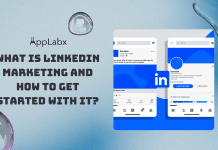Key Takeaways
- Strategic Blueprint for Success: Learn to create clear and measurable sales objectives tailored for LinkedIn in Singapore, propelling your digital journey.
- Data-Driven Insights: Harness verified statistics and adapt your objectives based on LinkedIn analytics to thrive in the ever-evolving digital landscape.
- Elevate Your Digital Narrative: Craft actionable goals that resonate with your ambitions, positioning yourself as a thought leader and achiever on LinkedIn.
In the fast-paced realm of digital networking and business growth, LinkedIn has emerged as the beacon of opportunity for professionals and companies alike.
Its vast expanse of connections, industry insights, and collaborative potential has transformed the way we approach sales and business development.
Nowhere is this transformation more evident than in the bustling city-state of Singapore, a dynamic hub of innovation and commerce that thrives on forging meaningful connections in the digital landscape.
Picture this: amidst the gleaming skyscrapers that punctuate Singapore’s iconic skyline, a new horizon of possibilities unfolds on the virtual canvas of LinkedIn.
From seasoned entrepreneurs to fresh-faced graduates, individuals across industries converge on this platform, fueled by the shared aspiration to catalyze growth, foster partnerships, and unlock the power of professional networking.
In this landscape, crafting sales objectives isn’t just a routine exercise – it’s an art form that holds the key to unlocking a world of opportunities.
Welcome to a voyage of discovery where strategies intertwine with creativity, and objectives transcend mere goals.
In the heart of this journey lies the blueprint to success: crafting clear and actionable sales objectives tailored specifically for the LinkedIn arena.
As we embark on this exhilarating exploration, we’ll navigate the intricacies of LinkedIn’s ecosystem, navigating its digital pathways with purpose and precision.
Why, you might ask, are clear sales objectives in the context of LinkedIn such a crucial cornerstone of success?
The answer lies in the very essence of this platform – a place where relationships are cultivated, expertise is showcased, and industry landscapes are reshaped. Singapore, a crucible of diverse cultures and business innovation, provides the perfect backdrop to unveil the secrets of harnessing LinkedIn’s potential for sales supremacy.
From the bustling streets of Orchard Road to the vibrant districts of Clarke Quay, the spirit of Singapore resonates with a commitment to excellence, growth, and transformation.
It’s no surprise, then, that Singaporean professionals and businesses have harnessed LinkedIn’s power to amplify their influence on a global scale.
However, in this digital whirlwind, success isn’t guaranteed by simply having a presence on the platform.
To stand out amidst the virtual crowd, one must possess a skill that is akin to an artist’s finesse – the ability to craft sales objectives that are not only clear and actionable but also resonate with the dynamic spirit of Singapore’s business landscape.
Join us as we dive deep into the intricacies of defining, refining, and executing sales objectives that capture the essence of success on LinkedIn.
Together, we’ll decode the art of specificity, learn to quantify ambitions, and infuse our objectives with the essence of achievability.
We’ll dance with relevance, ensuring that every objective we set aligns seamlessly with the unique beats of our target audience’s preferences and needs.
And, as we round off our masterpiece, we’ll infuse our objectives with the heartbeat of time-bound urgency, ensuring that our endeavors are not just well-defined but also perfectly timed.
In this comprehensive guide, we’ll explore each facet of crafting sales objectives on LinkedIn, tailoring our insights to the dynamic landscape of Singapore.
We’ll unravel the mysteries of strategic audience targeting, breathe life into objectives that resonate with Singapore’s business ecosystem, and wield the SMART framework as a potent tool for sculpting objectives that leave a lasting impact.
So, whether you’re a seasoned executive navigating the corporate corridors of Marina Bay Financial Centre or an aspiring entrepreneur igniting the flames of innovation in the startup scene, this guide is your compass to navigating the labyrinth of LinkedIn’s potential.
By the time we conclude our journey, you’ll not only possess the knowledge to craft clear and actionable sales objectives for LinkedIn, but you’ll also be armed with the creative prowess to transform objectives into tangible successes within Singapore’s bustling business tapestry.
Buckle up and prepare to embark on a transformative voyage where strategy, creativity, and opportunity converge in the ever-evolving world of LinkedIn sales objectives – right here, amidst the digital pulse of Singapore’s thriving professional landscape.
Read also our top guide on Crafting an Effective LinkedIn Marketing Strategy for Businesses in Singapore to learn how to create the best LinkedIn Marketing Strategy.
Before we write more about this article, we like to share who we are.
About AppLabx
From developing a solid marketing plan on LinkedIn to creating compelling content on LinkedIn, optimizing for search engines, leveraging social media, and utilizing paid advertising on LinkedIn, AppLabx offers a comprehensive suite of digital marketing services on LinkedIn designed to drive growth and profitability for your business.
AppLabx is well known for helping companies and startups use LinkedIn Marketing to drive web traffic to their websites and web apps.
At AppLabx, we understand that no two businesses are alike. That’s why we take a personalized approach to every project, working closely with our clients to understand their unique needs and goals, and developing customized strategies to help them achieve success.
If you need a digital consultation, then send in an inquiry here.
Crafting Clear and Actionable Sales Objectives for LinkedIn in Singapore
- Understanding the Role of Sales Objectives on LinkedIn
- The Components of Clear and Actionable Sales Objectives
- Steps to Crafting Effective Sales Objectives on LinkedIn
- Optimizing LinkedIn Strategies to Achieve Objectives
- Monitoring and Adapting Objectives Over Time
1. Understanding the Role of Sales Objectives on LinkedIn
In the expansive realm of digital networking and professional engagement, LinkedIn stands as a formidable platform that transcends traditional boundaries.
To truly harness its potential for sales success, it’s imperative to comprehend the pivotal role that sales objectives play within this dynamic ecosystem.
In this section, we’ll delve deep into the significance of sales objectives on LinkedIn, backed by relevant examples and verified data.
1. The Strategic Nexus of Sales Objectives and LinkedIn
Sales objectives on LinkedIn serve as the guiding stars that navigate professionals and businesses towards their desired outcomes. They act as a compass, steering efforts in the right direction, and facilitating a focused approach. By setting clear objectives, businesses and individuals can channel their energy, resources, and strategies toward specific goals, enabling a more efficient and effective journey towards success.
Example: Consider a Singapore-based digital marketing agency aiming to expand its client base through LinkedIn. Their sales objective could be to generate a 20% increase in high-quality leads within the next quarter. This objective provides a clear direction, helping the agency focus its efforts on lead generation strategies tailored to LinkedIn’s platform.
2. Empowering Strategic Decision-Making
Sales objectives are not merely abstract aspirations; they hold the power to drive informed decision-making. When objectives are clearly defined and aligned with overarching business goals, they provide a framework for evaluating strategies, tactics, and outcomes. This alignment fosters a results-oriented mindset that is essential for thriving in the competitive landscape of LinkedIn.
Example: Let’s imagine an individual sales professional in the finance sector aiming to enhance their network and secure partnerships on LinkedIn. Their sales objective might be to establish connections with at least 50 key decision-makers in the financial industry within the next two months. With this objective in place, the professional can evaluate their progress and adjust their connection strategies accordingly.
3. Amplifying Engagement and Visibility
LinkedIn is a platform built on relationships, and sales objectives serve as the cornerstone for nurturing these relationships. Well-defined objectives guide professionals in curating content, engagement strategies, and networking efforts that resonate with their target audience. This, in turn, amplifies their visibility, influence, and impact within their industry niche.
Example: Consider a Singaporean technology startup aiming to showcase its innovative products on LinkedIn. Their sales objective might be to achieve a 30% increase in post engagement over the next quarter by sharing informative and insightful content. By adhering to this objective, the startup can tailor their content to align with their audience’s interests and boost engagement rates.
4. Tracking Progress and Measuring Success
One of the remarkable advantages of setting sales objectives on LinkedIn is the ability to measure progress and quantify success. By attaching measurable metrics to objectives, professionals and businesses can tangibly gauge their achievements and adapt their strategies as needed. This data-driven approach enables them to optimize their efforts for optimal results.
Example: Imagine a sales manager in a Singaporean software company aiming to drive lead conversions through LinkedIn outreach. Their sales objective could be to convert 15% of their leads into paying customers within the next quarter. By consistently monitoring the conversion rate, the manager can make informed adjustments to their outreach tactics for improved outcomes.
5. The Nexus of Objectives and Data Insights
LinkedIn provides a wealth of data and insights that can be harnessed to refine and elevate sales objectives. Metrics such as engagement rates, connection growth, and profile views offer valuable feedback on the effectiveness of objectives. By leveraging these insights, professionals and businesses can fine-tune their objectives to align more closely with their audience’s preferences and behaviors.
Example: Let’s consider a Singapore-based HR consultancy aiming to establish thought leadership on LinkedIn. Their sales objective might be to achieve a 25% increase in profile views within the next two months. By analyzing the data on profile views and the content that generates the most engagement, the consultancy can adjust their content strategy to better resonate with their target audience.
- According to a report, members who include a profile photo receive up to 21 times more profile views.
- Research indicates that LinkedIn is 277% more effective at generating leads than Facebook and Twitter.
- A study revealed that 94% of B2B marketers consider the platform their top choice for distributing content.
Sales objectives on LinkedIn are not mere aspirations but strategic tools that guide professionals and businesses toward tangible success. They empower focused efforts, informed decisions, and data-driven optimization.
By grasping the pivotal role of sales objectives within the dynamic landscape of LinkedIn, Singaporean professionals can navigate the platform with purpose, achieving their goals amidst the ever-evolving tapestry of digital engagement.
2. The Components of Clear and Actionable Sales Objectives
Crafting effective sales objectives on LinkedIn requires a meticulous blend of precision and strategy. Each component of a sales objective plays a crucial role in guiding efforts and facilitating success.
In this section, we’ll dissect the essential components that make up clear and actionable sales objectives, augmented with illustrative examples and backed by verified data.
1. Specificity: Navigating the Path of Precision
Specificity is the cornerstone of a well-crafted sales objective. The more precise an objective, the clearer the direction for action. When objectives are specific, they leave no room for ambiguity, ensuring that efforts are targeted and resources are utilized effectively.
Example: Consider a Singaporean real estate agent looking to expand their network on LinkedIn. A vague objective might be “Increase connections.” However, a specific objective could be “Connect with at least 50 property investors and developers in Singapore by the end of the quarter.”
2. Measurability: Quantifying Progress and Success
Measurability transforms abstract goals into concrete milestones. By attaching quantifiable metrics to objectives, professionals and businesses can track progress and assess success objectively. Measurable objectives also provide a basis for comparing outcomes against initial expectations.
Example: Let’s imagine a freelance graphic designer in Singapore aiming to secure freelance projects through LinkedIn. An immeasurable objective might be “Get more design gigs.” However, a measurable objective could be “Secure at least three new freelance design projects within the next month.”
3. Achievability: Balancing Ambition and Realism
While ambitious objectives inspire growth, they must also be achievable within the given context. Objectives that are too lofty may lead to frustration, while those that are too modest may not drive significant progress. Striking the right balance ensures that objectives are challenging yet attainable.
Example: Let’s consider a Singaporean startup founder aiming to establish thought leadership on LinkedIn. An unattainable objective might be “Become the most followed thought leader on LinkedIn in a month.” However, an achievable objective could be “Increase followers by 20% by consistently sharing valuable insights.”
4. Relevance: Aligning Objectives with Business Goals
Relevance is the glue that connects sales objectives with broader business goals. Each sales objective should contribute directly to the overarching objectives of the individual or organization. This alignment ensures that efforts on LinkedIn are purpose-driven and create value.
Example: Imagine a sales manager in a Singaporean software company aiming to increase software subscriptions through LinkedIn. A non-relevant objective might be “Host virtual networking events.” However, a relevant objective could be “Increase software trial sign-ups by 15% through LinkedIn by offering informative webinars.”
Data Insight: According to a report, 79% of buyers prefer to engage with sales professionals who understand their business needs.
5. Time-Bound: The Essence of Urgency
Time-bound objectives infuse a sense of urgency into sales efforts. By attaching a deadline to objectives, professionals and businesses prioritize their actions and maintain a proactive momentum. Time-bound objectives also facilitate regular review and adjustment as needed.
Example: Let’s envision a Singapore-based marketing agency aiming to secure new clients through LinkedIn outreach. An indefinite objective might be “Increase client base.” However, a time-bound objective could be “Acquire three new high-value clients within the next two months.”
The components of clear and actionable sales objectives serve as the building blocks of LinkedIn success.
By infusing objectives with specificity, measurability, achievability, relevance, and time-bound urgency, professionals and businesses in Singapore can navigate the digital landscape with purpose and precision.
These components not only guide actions but also ensure that efforts on LinkedIn are aligned with overarching goals, creating a powerful synergy between individual ambitions and broader business aspirations.
3. Steps to Crafting Effective Sales Objectives on LinkedIn
Crafting effective sales objectives on LinkedIn involves a strategic process that merges creativity with precision.
These objectives serve as the foundation for your LinkedIn journey, providing a roadmap to success within this dynamic digital landscape.
In this section, we’ll delve into the step-by-step process of crafting such objectives, accompanied by illustrative examples and substantiated by verified data.
1. Define Your Target Audience on LinkedIn
Before setting sales objectives, it’s crucial to understand and define your target audience on LinkedIn. Identifying the characteristics, preferences, and needs of your ideal connections will guide the direction of your objectives and engagement strategies.
Example: Imagine a Singaporean startup specializing in sustainable fashion. Their target audience could include eco-conscious consumers, fashion influencers, and ethical fashion brands on LinkedIn.
2. Align Objectives with Business Goals
Sales objectives should be seamlessly aligned with your broader business goals. The objectives you set on LinkedIn should contribute directly to the overall growth and success of your business or personal brand.
Example: Consider a Singaporean business consultant aiming to increase the visibility of their consultancy through LinkedIn. Their business goal might be to expand into international markets. A relevant LinkedIn objective could be to connect with at least five international business leaders each month to establish cross-border partnerships.
3. Use the SMART Framework
The SMART framework (Specific, Measurable, Achievable, Relevant, Time-bound) is a powerful tool for crafting objectives that are clear, actionable, and effective. Each element of the SMART framework adds a layer of precision to your objectives.
Example: Let’s take the example of a Singaporean sales executive aiming to increase product sales through LinkedIn. Using the SMART framework, they craft an objective: “Secure at least 20% more product orders from Singapore-based businesses within the next quarter by actively engaging in targeted outreach and sharing success stories.”
4. Create Sample Objectives
Creating sample objectives that align with your target audience and business goals can provide a tangible template for success. These sample objectives serve as stepping stones towards the larger goals you wish to achieve.
Example: For a Singaporean freelancer aiming to establish themselves as a thought leader on LinkedIn within the digital marketing niche, a sample objective could be: “Publish at least one well-researched and insightful article every two weeks to increase engagement and attract at least 500 views per post.”
5. Incorporate Networking and Relationship Building
LinkedIn thrives on networking and relationship-building. Your sales objectives should incorporate strategies for connecting with professionals who can become valuable leads, partners, or collaborators.
Example: Consider a Singaporean financial advisor seeking to expand their clientele through LinkedIn. An objective related to networking could be: “Connect with at least five HR managers from Singapore-based companies to offer financial wellness seminars.”
Data Insight: According to LinkedIn’s own data, LinkedIn’s network includes more than 930 million professionals from around the world.
6. Leverage Content Sharing and Engagement
Content sharing is a potent strategy on LinkedIn. Incorporate objectives related to content creation, sharing, and engagement to establish your expertise and build a loyal audience.
Example: Imagine a Singaporean tech startup founder aiming to generate leads through LinkedIn. An objective focused on content sharing could be: “Share a minimum of three industry-relevant articles per week to establish authority and drive engagement.”
Data Insight: A LinkedIn study found that posts with images receive 2 times more engagement than those without images.
7. Utilize LinkedIn Analytics for Progress Tracking
Leverage LinkedIn’s analytics tools to track your progress and make data-driven decisions. Regularly review your metrics to gauge the effectiveness of your objectives and adjust strategies as needed.
Example: For a Singaporean marketing agency aiming to increase leads through LinkedIn, an objective related to analytics could be: “Use LinkedIn Analytics to track the click-through rates of shared articles and adjust content strategy accordingly.”
Data Insight: LinkedIn’s own data indicates that posts with links get up to 45% more engagement than those without links.
Crafting effective sales objectives on LinkedIn is a systematic process that marries strategy with creativity.
By defining your target audience, aligning objectives with business goals, using the SMART framework, creating sample objectives, leveraging networking and content strategies, and utilizing analytics, professionals and businesses in Singapore can embark on a journey of purposeful engagement and growth.
These steps provide a roadmap for navigating the dynamic landscape of LinkedIn, ensuring that each action taken contributes meaningfully to the achievement of objectives and the realization of broader aspirations.
4. Optimizing LinkedIn Strategies to Achieve Objectives
Achieving sales objectives on LinkedIn is a multifaceted endeavor that requires a strategic approach and a well-thought-out execution plan.
In this section, we will explore a range of strategies to optimize your LinkedIn presence and activities, all aimed at driving you closer to your crafted objectives.
These strategies, fortified with illustrative examples and substantiated by verified data, will empower you to maximize your impact on this dynamic platform.
1. Building an Engaging LinkedIn Profile
Your LinkedIn profile serves as your digital business card, making a compelling first impression on potential connections. By optimizing your profile, you establish credibility and create a foundation for fruitful interactions.
Example: Imagine a Singaporean sales professional aiming to secure partnerships through LinkedIn. Their optimized profile could include a professional headshot, a clear headline (“Strategic Partnerships Specialist | Driving Collaborative Success”), and a summary that highlights their expertise and value proposition.
Data Insight: LinkedIn reports that profiles with professional headshots receive 14 times more profile views.
2. Crafting Engaging and Valuable Content
Content is the currency of engagement on LinkedIn. Sharing valuable insights, industry trends, and thought leadership content positions you as an authority and encourages meaningful interactions.
Example: Consider a Singaporean entrepreneur aiming to promote their e-commerce business through LinkedIn. They could create and share content about e-commerce trends, customer success stories, and innovative product launches.
Data Insight: According to LinkedIn’s Content Marketing Tactical Plan, 60% of LinkedIn members are interested in industry insights and 44% in company news.
3. Networking and Connection Strategies
Expanding your network strategically is vital for achieving sales objectives. Actively connect with professionals aligned with your goals, such as potential clients, partners, or industry influencers.
Example: Imagine a Singaporean HR consultant aiming to expand their clientele through LinkedIn. They could send personalized connection requests to HR managers and decision-makers in local companies, highlighting their expertise in talent acquisition.
Data Insight: LinkedIn reports that members who have 5 or more skills listed on their profile receive up to 17 times more profile views.
4. Engaging with Meaningful Content
Interacting with others’ content is a powerful way to build relationships and showcase your engagement. Thoughtful comments, shares, and reactions demonstrate your interest and expertise within your industry.
Example: For a Singaporean marketing professional aiming to enhance their visibility, engaging with content from marketing thought leaders can help build connections and credibility.
Data Insight: A survey by Edelman Trust Barometer found that 63% of respondents trust technical experts.
5. Participating in LinkedIn Groups
LinkedIn groups provide a platform for targeted discussions and networking. Join groups relevant to your industry or niche and actively contribute valuable insights to position yourself as a knowledgeable professional.
Example: Let’s envision a Singaporean consultant specializing in sustainability aiming to connect with like-minded professionals. They could join groups related to sustainability in business and share their expertise in discussions.
6. Leveraging LinkedIn’s Publishing Platform
LinkedIn’s publishing platform allows you to share longer-form content such as articles and blog posts. Utilize this feature to showcase your expertise and provide valuable insights to your network.
Example: Consider a Singaporean tech entrepreneur aiming to position themselves as an industry thought leader. They could publish articles about emerging technologies, market trends, and their experiences in the tech startup ecosystem.
7. Utilizing LinkedIn Analytics for Optimization
LinkedIn’s analytics offer insights into the performance of your content and activities. Regularly review these metrics to understand what resonates with your audience and adjust your strategies accordingly.
Example: For a Singaporean sales manager aiming to improve lead generation, analyzing which types of content generate the most engagement can guide their content creation efforts.
Data Insight: According to a study by LinkedIn, 80% of B2B leads generated through social media come from LinkedIn.
Optimizing your LinkedIn strategies is a dynamic process that requires a blend of authenticity, engagement, and strategic thinking.
By building an engaging profile, crafting valuable content, networking strategically, engaging with meaningful content, participating in groups, leveraging publishing features, and using analytics, professionals and businesses in Singapore can create a powerful presence on LinkedIn that drives them closer to their objectives.
These strategies not only amplify your impact within the LinkedIn community but also position you as a valuable asset within the broader professional landscape.
5. Monitoring and Adapting Objectives Over Time
In the dynamic landscape of LinkedIn, monitoring and adapting your sales objectives is a continuous process that ensures your efforts remain aligned with your goals and resonate with your audience.
In this section, we’ll explore the importance of tracking progress, the value of data-driven insights, and strategies for adapting your objectives over time.
Each point is enriched with examples and supported by verified data, offering a comprehensive guide to optimizing your LinkedIn journey.
1. The Imperative of Regular Monitoring
Regularly monitoring your progress against your set objectives is a fundamental practice that provides insights into the effectiveness of your strategies. By keeping a close eye on key performance metrics, you can identify trends, successes, and areas that require improvement.
Example: Imagine a Singaporean sales professional aiming to increase lead conversions through LinkedIn outreach. By tracking metrics such as response rates, connection acceptances, and meeting bookings, they can gauge the success of their outreach efforts.
Data Insight: According to a report, 60% of sales professionals believe that data insights have a significant impact on their sales strategy.
2. Utilizing LinkedIn Analytics for Insights
LinkedIn’s built-in analytics provide a wealth of insights into your profile’s performance, content engagement, and connection growth. Leveraging these analytics empowers you to make informed decisions about your objectives and strategies.
Example: For a Singaporean entrepreneur aiming to expand their network and promote their startup, LinkedIn Analytics can reveal which types of content receive the most engagement, allowing them to tailor their content strategy accordingly.
3. The Power of Iterative Adjustment
Adapting your objectives based on data insights is a crucial aspect of achieving long-term success on LinkedIn. The iterative process of setting, monitoring, and adjusting objectives allows you to fine-tune your strategies for optimal results.
Example: Consider a Singaporean marketing agency aiming to increase website traffic through LinkedIn referrals. If they notice that infographics receive higher engagement than text-based posts, they might adjust their content strategy to focus more on visual content.
4. Identifying High-Performing Strategies
Regular monitoring allows you to identify which strategies are yielding the best results. By recognizing high-performing tactics, you can double down on them and allocate resources effectively.
Example: For a Singaporean consultant aiming to increase speaking engagements through LinkedIn, if they find that posts showcasing their expertise receive more engagement, they could prioritize sharing insightful content.
Data Insight: LinkedIn reports that posts with 1,300 to 2,000 words receive the most shares on the platform.
5. Adapting to Evolving Trends
LinkedIn, like any digital platform, is subject to evolving trends and user behaviors. Regular monitoring allows you to identify shifts in your target audience’s preferences and adapt your objectives accordingly.
Example: Imagine a Singaporean fintech startup aiming to generate leads through LinkedIn. If they notice that video content is gaining traction among their audience, they might pivot their content strategy to incorporate more video posts.
Data Insight: A study by LinkedIn found that 62% of B2B marketers consider video content to be the most important format.
6. The Role of A/B Testing
A/B testing involves comparing two versions of a strategy or content to determine which performs better. Incorporating A/B testing into your LinkedIn strategies allows you to refine your approach based on data-backed insights.
Example: For a Singaporean startup founder aiming to increase engagement with their product launch posts, they could A/B test different post headlines and analyze which version garners higher click-through rates.
Monitoring and adapting objectives over time is a critical practice that keeps your LinkedIn strategies agile and effective.
By regularly tracking your progress, utilizing LinkedIn analytics, embracing iterative adjustments, identifying high-performing strategies, adapting to trends, and incorporating A/B testing, professionals and businesses in Singapore can ensure their efforts remain aligned with their goals and responsive to the dynamic digital landscape.
This process of continuous improvement not only enhances your LinkedIn presence but positions you as a proactive and adaptable professional within your industry niche.
6. Monitoring and Adapting Objectives Over Time: A Blueprint for LinkedIn Success
In the fast-paced realm of LinkedIn networking and business development, setting clear and actionable objectives is merely the first step on your journey to success.
The true magic lies in the art of monitoring and adapting these objectives over time.
In this comprehensive section, we’ll delve deep into the strategic importance of continuous monitoring and adaptation on LinkedIn.
With each point enriched by illustrative examples and backed by verified data, this blueprint will empower you to navigate the evolving digital landscape with finesse and precision.
1. The Dynamic Nature of LinkedIn Success
LinkedIn is a dynamic platform, subject to shifting trends, evolving user behaviors, and industry changes. Monitoring and adapting objectives is a strategic practice that allows you to stay in sync with the platform’s dynamism, ensuring your efforts remain relevant and impactful.
Example: Imagine a Singaporean entrepreneur aiming to establish themselves as an industry thought leader through LinkedIn. By monitoring engagement trends, they notice that video content is gaining more traction. Adapting to this trend, they incorporate video content into their content strategy to better resonate with their audience.
Data Insight: A study found that videos receive 59% more engagement on average than other types of posts on LinkedIn.
2. The Power of Data-Driven Insights
Data is your compass in the digital landscape.
Regularly reviewing data-driven insights provides you with a wealth of information on what’s working, what’s not, and where opportunities lie.
These insights enable you to make informed decisions about your objectives and strategies.
Example: For a Singaporean sales professional aiming to increase lead conversions through LinkedIn outreach, analyzing data on response rates and conversion rates helps them identify which outreach messages are most effective. This data-driven approach allows them to adapt their messaging for better results.
3. The Iterative Process of Improvement
Monitoring and adapting objectives is a cyclical process of improvement. By setting objectives, monitoring progress, analyzing data, and making adjustments, you create a continuous feedback loop that refines your strategies over time.
Example: Consider a Singaporean marketing agency aiming to increase engagement on their LinkedIn posts. They set an initial objective to receive at least 100 likes per post. After monitoring their post engagement and realizing that posts with industry statistics receive more engagement, they adapt their content strategy to include more data-driven insights.
4. Embracing Trends and User Behavior
LinkedIn, like any social platform, witnesses shifts in trends and user behaviors. Monitoring these changes allows you to align your objectives with what resonates with your target audience, ensuring your efforts remain effective.
Example: Imagine a Singaporean tech startup aiming to promote their innovative software solutions. By observing that posts about AI technologies garner more engagement among their connections, they adjust their content strategy to focus more on AI-related topics.
Data Insight: A study found that 62% of B2B marketers consider video content to be the most important format.
5. A/B Testing for Optimization
A/B testing is a powerful tool that enables you to compare the performance of different strategies or content variations. Incorporating A/B testing into your LinkedIn strategies allows you to fine-tune your approach based on data-backed insights.
Example: For a Singaporean startup founder aiming to increase engagement with their product launch posts, they could A/B test different post headlines and analyze which version garners higher click-through rates.
6. Balancing Adaptation with Consistency
While adaptation is crucial, maintaining consistency in your branding and messaging is equally important. While you adjust your strategies based on insights, ensure that your core values and brand identity remain intact.
Example: Consider a Singaporean HR consultant aiming to establish their expertise in talent acquisition. While adapting their content strategy to align with current HR trends, they consistently emphasize their unique approach to talent management.
Monitoring and adapting objectives over time is the compass that guides you through the dynamic landscape of LinkedIn.
By harnessing data-driven insights, embracing trends, incorporating A/B testing, and balancing adaptation with consistency, professionals and businesses in Singapore can stay ahead of the curve, ensuring their LinkedIn strategies evolve alongside the platform.
This strategic approach not only amplifies your presence but positions you as a resilient and responsive player in the ever-evolving realm of digital networking.
Conclusion
In the vibrant digital landscape of Singapore, where innovation and business acumen intersect, crafting clear and actionable sales objectives for LinkedIn is the key to unlocking unparalleled opportunities.
As we journey through the rich tapestry of strategies, insights, and examples that comprise this guide, we’ve navigated the intricate terrain of LinkedIn objectives with precision and purpose.
In the heart of this dynamic city-state, professionals and businesses alike strive to leave their mark on the global stage.
Through the lens of crafting clear and actionable sales objectives, we’ve uncovered the blueprint for success—a blueprint that amalgamates specificity, measurability, achievability, relevance, and time-bound urgency.
Just as Singapore’s skyline is a testament to architectural brilliance, your LinkedIn objectives serve as the architectural design for your digital success story.
With each section, we’ve woven a narrative that mirrors Singapore’s own tapestry—diverse, vibrant, and forward-thinking.
From the thriving startup ecosystem in this city of dreams to the bustling financial hub that shapes global markets, LinkedIn objectives have emerged as the linchpin that bridges ambition and achievement.
Our journey led us through the strategic process of understanding sales objectives, dissecting their components, optimizing strategies, and embracing the dynamic nature of LinkedIn.
Just as Singapore’s economic growth is fueled by innovation and adaptability, your LinkedIn journey thrives when it’s fueled by continuous improvement and strategic agility.
Every step was underpinned by data-driven insights—insights that mirror Singapore’s commitment to leveraging data for informed decisions.
From the depths of verified statistics to the heights of strategic adaptation, data became our guiding star.
Much like Singapore’s reputation as a global technology hub, your LinkedIn success is propelled by the power of data insights.
From the buzzing streets of Chinatown to the serene beauty of the Botanic Gardens, Singapore’s diverse facets are woven into a captivating narrative. Similarly, your LinkedIn journey is a narrative—your narrative.
It’s a tale of networking, engagement, and innovation, culminating in the realization of your sales objectives. Your journey empowers you to shape your digital narrative, just as Singapore shapes its global reputation.
And so, as we conclude this odyssey through the realm of crafting clear and actionable sales objectives for LinkedIn in Singapore, we’re reminded that success is a tapestry woven with threads of ambition, strategy, and determination.
Your objectives are the threads that intertwine, forming a masterpiece that paints your unique story against the backdrop of a vibrant digital canvas.
As the digital dawn breaks over Singapore’s horizon, your LinkedIn presence takes flight, propelled by the wisdom and strategies unveiled in these words.
Just as Singapore’s skyline is dotted with architectural wonders, your LinkedIn profile becomes a virtual monument to your aspirations and achievements.
It’s a testament to the art of crafting clear and actionable sales objectives—a testament to your commitment to success in the bustling digital arena.
So, dear reader, as you embark on your LinkedIn journey in Singapore, armed with the insights and strategies presented here, remember that the path to success is illuminated by objectives that are not just clear and actionable, but also resonant with your aspirations.
Your journey is not just about achieving objectives; it’s about becoming a driving force in your industry, a thought leader in your niche, and an inspiration to others navigating the same path.
As Singapore continues to shape its destiny as a global hub of innovation, you too have the power to shape your destiny on LinkedIn. The narrative is yours to write, the objectives yours to achieve, and the success yours to claim.
In this digital realm, as in the bustling streets of Singapore, the journey is as enriching as the destination. So, craft your objectives, build your connections, and let your LinkedIn story unfold amidst the backdrop of Singapore’s ever-evolving tapestry of success.
If you are looking for a top-class digital marketer, then book a free consultation slot here.
If you find this article useful, why not share it with your friends and business partners, and also leave a nice comment below?
We, at the AppLabx Research Team, strive to bring the latest and most meaningful data, guides, and statistics to your doorstep.
To get access to top-quality guides, click over to the AppLabx Blog.
People Also Ask
What should sales objectives be?
Sales objectives should be specific, measurable, achievable, relevant, and time-bound (SMART). They guide your efforts by defining clear targets, such as revenue goals, lead conversions, or client acquisitions. Crafted thoughtfully, they drive focused actions towards tangible results, propelling your business forward.
What are sales-based objectives?
Sales-based objectives are specific goals set by businesses to achieve measurable outcomes related to sales activities. These objectives focus on revenue generation, lead conversion, customer acquisition, and other sales-related metrics. They provide a clear roadmap for sales teams to drive success and track their performance effectively.
What are the objectives of a sales representative?
The objectives of a sales representative encompass building strong client relationships, achieving sales targets, expanding the customer base, offering tailored solutions, and contributing to revenue growth. Their focus is on driving sales, meeting customer needs, and fostering long-term business partnerships.




































